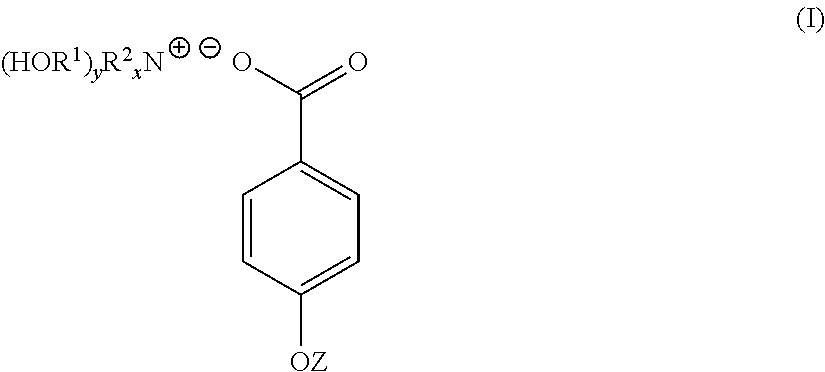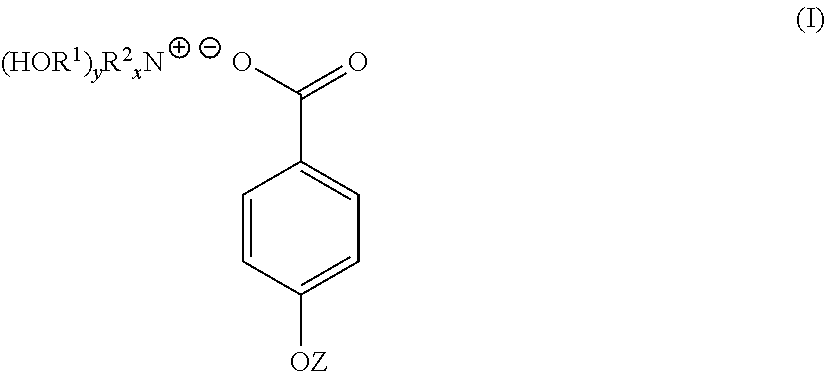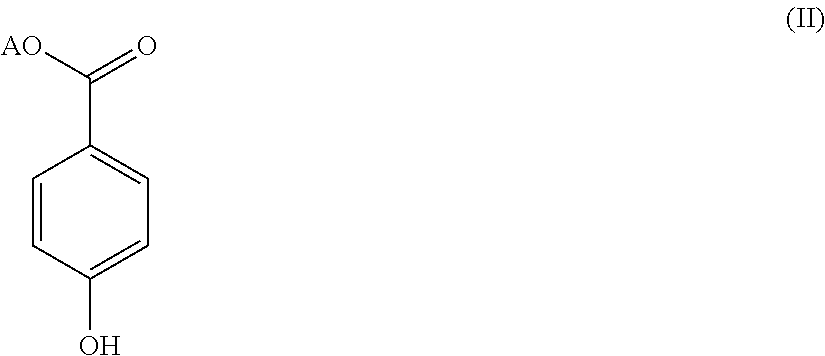4-hydroxy benzoate derivatives for use in the treatment of infection, inflammation or pain
a technology of benzoate derivatives and derivatives, which is applied in the preparation of amino-hyroxy compounds, carboxylic compounds, carboxylic acid salts, etc., can solve the problems of limited or no effective preventative or curative treatment, infection, inflammation and/or pain, and the skin of patients may be subject to steroidal treatmen
- Summary
- Abstract
- Description
- Claims
- Application Information
AI Technical Summary
Benefits of technology
Problems solved by technology
Method used
Image
Examples
example 1
Preparation and Characterisation of triethanolammonium 4-hydroxybenzoate (TEAB)
[0049]4-hydroxybenzoic acid (10.6 g, 0.08 mol) was dissolved in acetone (200 mL). To the 4-hydroxybenzoic acid solution was added a solution of triethanolamine (9.23 g, 0.07 mol) dissolved in a water (70 mL) / acetone (200 mL) mixture yielding a clear solution. The solution was stirred at room temperature for 1 hour. The solution was stripped of acetone on a rotary evaporator to yield 91 g (100%) of a light yellow solution with n20d of 1.3890. This light yellow solution was found to contain 30% by weight of TEAB in water. A sample of the light yellow solution was reduced to near dryness yielding a white crystalline solid identified as TEAB containing 0.3 moles of water per mole of solid (93-94 C).
[0050]To establish the ionic nature of TEAB, 10 g of the light yellow TEAB solution was blended with water (300 mL) and Dowex MB-3 ion exchange resin (Dow Chemical Company) and left to stand overnight. At this time...
example 2
Preparation of triethanolammonium 4-hydroxybenzoate (TEAB)
[0052]Triethanolamine (149 g, 1 mol) was dissolved in water (287 mL). To this solution was added solid 4-hydroxybenzoic acid (138 g, 1 mol) over a period of 3 to 4 minutes. As the solid 4-hydroxybenzoic acid was added it reacted and dissolved increasing the temperature of the reaction mixture 5° C. After overnight standing, 573 g (100%) of a light yellow TEAB solution was recovered with n20d of 1.4484 and pH of 6.61. 40 g of the light yellow TEAB solution was reduced to 23 g on a rotary evaporator and this solution poured into acetone (300 mL). After 72 hours, a white crystalline solid was filtered off, washed with acetone and oven dried at 60° C. (m.p. 93-94 C). Yield 19 g.
example 3
Preparation of tetraethanolammonium 4-hydroxybenzoate
[0053]1-bromoethanol (100 g, 0.8 mol) and triethanolamine (119 g, 0.8 mol) were added to absolute ethanol (300 mL) and heated to 60 C while stirring. No apparent reaction was observed. After 2 weeks at room temperature stirring the reaction mixture contained a white crystalline solid which was filtered off, washed with ethanol and oven dried at 60 C to yield 5 g of tetraethanolammonium bromide (m.p. 189 C).
[0054]A 45% by weight aqueous solution of potassium hydroxide (100 g, 0.8 mol) was added to water (200 mL). To this solution with stirring was added 4-hydroxybenzoic acid (111 g, 0.8 mol). The mixture was stirred for 12 hours at room temperature to yield a white crystalline solid which was filtered off, washed well with acetone and dried. The white crystalline solid was potassium 4-hydroxybenzoate (m.p. 214 C).
[0055]Tetraethanolammonium bromide (4.58 g, 0.026 mol) and potassium 4-hydroxybenzoate (7.16 g, 0.026 mol) were dissolve...
PUM
 Login to View More
Login to View More Abstract
Description
Claims
Application Information
 Login to View More
Login to View More - R&D
- Intellectual Property
- Life Sciences
- Materials
- Tech Scout
- Unparalleled Data Quality
- Higher Quality Content
- 60% Fewer Hallucinations
Browse by: Latest US Patents, China's latest patents, Technical Efficacy Thesaurus, Application Domain, Technology Topic, Popular Technical Reports.
© 2025 PatSnap. All rights reserved.Legal|Privacy policy|Modern Slavery Act Transparency Statement|Sitemap|About US| Contact US: help@patsnap.com



